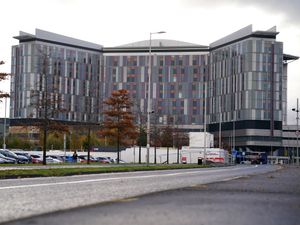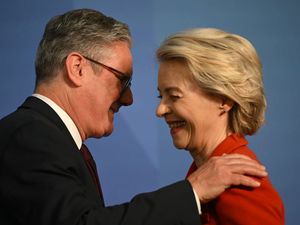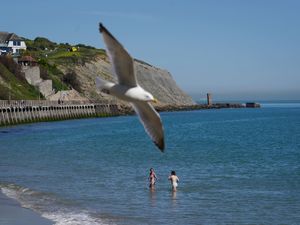Doctor advised to ‘pipe down’ and not raise infection risk concerns – inquiry
The Scottish Hospitals Inquiry is investigating the construction of the Queen Elizabeth University Hospital campus in Glasgow.

A microbiologist has told an inquiry she was advised to “pipe down” when she tried to flag problems at a Glasgow hospital at the centre of infection concerns.
Dr Christine Peters, who started work as a consultant microbiologist at Queen Elizabeth University Hospital (QEUH) in 2014, told the Scottish Hospitals Inquiry that she had been advised she would “make things difficult” for herself if she kept raising concerns.
On Wednesday, she told the inquiry she could not remain silent, explaining: “I just I can’t get my head around that idea at all. I think you’ve got a duty to patients, you’ve got to act in their best interest.”
She told the inquiry, being chaired by Lord Brodie KC, that she first became aware of issues at QUEH in October 2014.
The inquiry heard that in the ensuing months she tried to raise concerns about a number of patient safety issues, including around the air ventilation system, the design of sinks, and the suitability of wards intended for patients undergoing bone marrow transplants.
However, she said she was frustrated by a dysfunctional management culture that failed to take her concerns seriously or to respond with urgency.
She said that at one stage she was “criticised for sending too many emails”.
She also recalled that on one occasion she was advised by a fellow microbiologist to “pipe down”, saying in her written statement to the inquiry: “I expressed my concerns about the building and the infection control set-up within the board and he specifically said to me ‘why would you raise your head above the parapet?’.
“He also encouraged me to ‘pipe down’ as otherwise I would find things hard.”

The problems escalated to the point that, in early July 2015, she tried to resign from her role as infection control doctor (ICD) within the hospital, but was unable to do so because nobody else was willing to do the job.
“By this stage it wasn’t just that there were problems,” she said.
“A lot of infection control is picking up problems, so you don’t expect to never pick up problems.
“The real big dealbreaker for me was that there didn’t seem to be the correct levers to try and do your job, and at least find a way through the problems in a way that was controlled, good governance, collaborative, good practice, or just normal functional working.”
She added: “I felt that I couldn’t in good conscience carry on.”
She also criticised a “lack of transparency” on the part of management, and said nobody else wanted to replace her as an ICD as “they found the set-up unsafe.”
She added: “People were scared of going to senior management team meetings. Scared to speak up, scared of the ICD meetings. There was fear involved.
“There’s a toxic relationship in the (ICD) team, and I wasn’t the only one to experience it.”
During the morning session, she said that she had concerns about wards 4B and 2A, where very vulnerable patients were undergoing bone marrow transplants.
She explained that air quality testing in wards 4B and 2A in late June 2015 found particle counts “in the millions” rather than the “less than one” that would be expected.
She added there was “Lots of fungus on all the (testing) plates, and huge counts in some of the rooms, massive counts, as big as outdoor counts.”
However, she added that “you’d say that’s not surprising” given the problems with the ventilation system, which wasn’t maintaining the right air pressure inside the wards.
The inquiry chair, Lord Brodie, asked Dr Peters why action was taken to address the problems in 4B but not 2A, given high numbers of airborne particles were found in both wards.
Dr Peters said: “I think it speaks to a lack of a joined up approach, where we really needed to say, ‘let’s start again from scratch, we don’t actually know what we have. And take it from there’.”
She added: “Things seemed to happen in pockets of activity across the organisation that I wasn’t privy to.
“From my limited visibility, I raised things, got involved, and then (was) blocked out, and there’s no further information.
“And you’re then in the position where you’re hoping something’s happening, but not in the sure knowledge that something’s happening.”
She also told the inquiry that she had been “very shocked” to be told by a senior manager in 2014, soon after she joined the hospital, not to raise concerns in writing in case there was an inquiry.
She said that after an infection issue in the old Southern General hospital building, she had written an email setting out lessons learned, only to receive a phone call from a senior colleague telling her: “You’re in Glasgow now. We don’t put things in writing because of inquiries and things.
“I remember the words, and I was pretty shocked.”
Lord Brodie pressed her if she was “clear” that he had said this, and she replied: “Very clear indeed.”
The inquiry is currently investigating the construction of the QEUH campus in Glasgow, which includes the Royal Hospital for Children.
The inquiry was launched in the wake of deaths linked to infections, including that of 10-year-old Milly Main.
An NHS Greater Glasgow and Clyde (NHSGGC) spokesman said: “These matters are to be explored in the ongoing inquiry and while NHSGGC continues to co-operate with the inquiry, it would be inappropriate to comment on this at this time.”
The inquiry continues.





